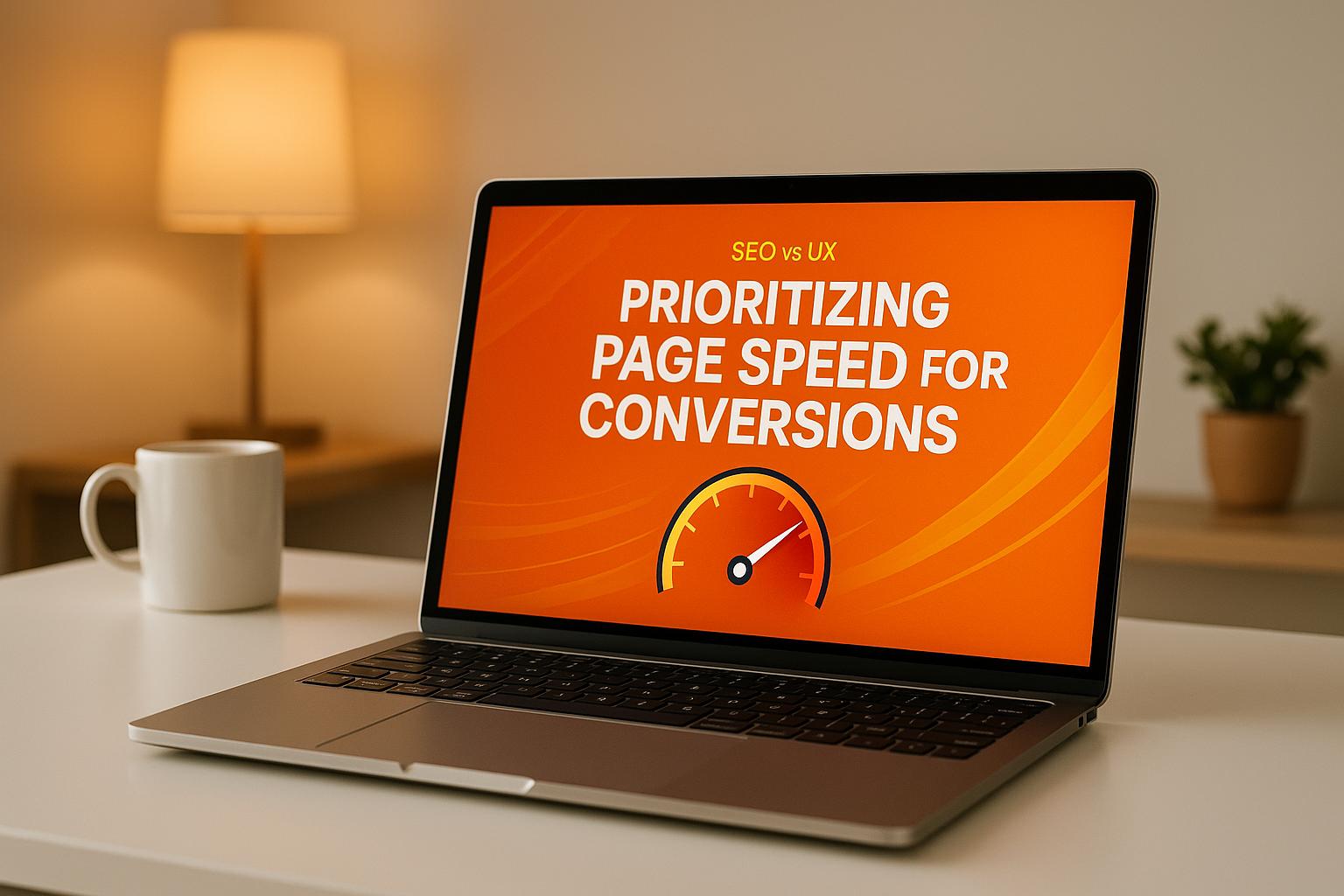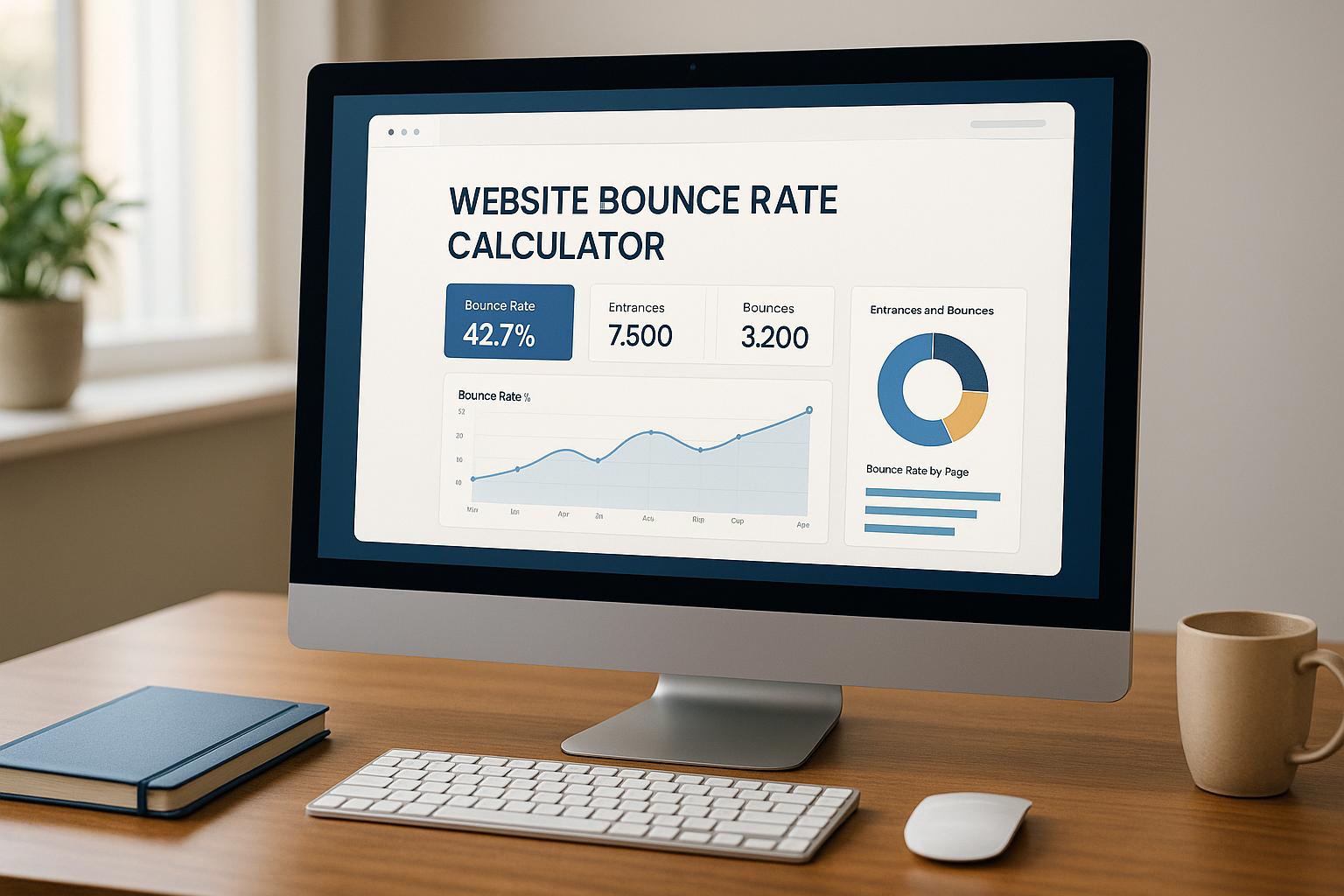

SEO vs UX: Prioritizing Page Speed for Conversions

SEO vs UX: Prioritizing Page Speed for Conversions
 08-09-2025 (Last modified: 08-09-2025)
08-09-2025 (Last modified: 08-09-2025)
Page speed directly impacts your site’s success. It affects search rankings, user experience, and conversion rates. A slow website can frustrate users, reduce engagement, and hurt your SEO, while a fast site improves visibility, trust, and sales.
Key takeaways:
- SEO: Google uses page speed as a ranking factor, focusing on metrics like Core Web Vitals (LCP, FID, CLS). Faster pages rank higher and improve crawl efficiency.
- UX: Users expect fast, responsive pages. Slow load times lead to higher bounce rates and lower trust, especially on mobile.
- Conversions: Every second of delay reduces conversions by 7%. Faster pages attract more traffic and encourage user actions like purchases or sign-ups.
Balancing SEO and UX: Both benefit from better page speed, but their priorities differ. SEO focuses on technical metrics, while UX emphasizes user satisfaction. To succeed, optimize for both by improving load times, interactivity, and visual stability.
Tools to improve page speed: Platforms like PageTest.AI help test and optimize speed while tracking its impact on conversions. Combining technical fixes with user-focused improvements ensures better results for both SEO and UX.
Page speed isn’t just about numbers – it’s about keeping users engaged and driving business growth.
Visualizing Speed Metrics to Improve SEO, UX, & Revenue – Whiteboard Friday
Page Speed’s Impact on SEO
Page speed plays a crucial role in how search engines rank your site, directly influencing your organic traffic. Let’s break down why this matters and the challenges it presents.
Page Speed as a Ranking Factor
Google made page speed a ranking factor for desktop searches back in 2010 and extended this to mobile searches with the 2018 Speed Update. In simple terms, faster-loading pages have an edge over slower ones in search rankings.
But it’s not just about how quickly a page loads anymore. Google now evaluates user-focused performance metrics, prioritizing how real users experience your site over purely technical benchmarks.
Faster pages also improve your crawl budget, which is the amount of your site that search engines can index within a given time. For large websites, every second shaved off load time means more content gets discovered and ranked. Plus, faster sites generally see lower bounce rates, signaling to search engines that your content is relevant and engaging.
For competitive keywords, even small improvements in page speed can lead to noticeable ranking gains. This makes page speed optimization a powerful tool in your SEO strategy.
Core Web Vitals and SEO
Google’s Core Web Vitals are now key indicators of site performance and user experience, making them essential for SEO. These metrics measure specific aspects of page speed and overall usability:
- Largest Contentful Paint (LCP): Tracks loading performance by measuring when the largest visible element appears. A good score is 2.5 seconds or less.
- First Input Delay (FID): Measures interactivity by recording the time between a user’s first action and the browser’s response. A good score is under 100 milliseconds.
- Cumulative Layout Shift (CLS): Assesses visual stability by monitoring unexpected layout shifts during loading. A score below 0.1 is ideal.
These metrics are part of Google’s “page experience” signal, meaning strong scores across all three can give you a ranking edge. Beyond rankings, they highlight why speed matters for both user satisfaction and SEO success.
SEO Problems from Slow Pages
While fast pages boost conversions and rankings, slow-loading ones create a host of SEO challenges.
Crawl budget issues are a common problem. Search engines allocate a limited amount of resources to crawl your site. Slow pages take up more of this budget, potentially leaving new or updated content unindexed.
Negative user signals also hurt your rankings. If visitors abandon your site because of slow load times, Google interprets this as poor content relevance or a bad user experience, which can lower your rankings.
Mobile search penalties are especially damaging. With Google’s mobile-first indexing, your mobile page speed directly impacts how your entire site performs in search results. A slow mobile experience can pull down rankings for both mobile and desktop searches.
Ultimately, slow page speed doesn’t just affect individual pages – it can harm your entire site’s SEO. Search engines may crawl your site less often, index fewer pages, and lower your domain authority, all because of sluggish performance.
How Page Speed Affects User Experience
Page speed isn’t just about rankings – it plays a huge role in how people experience your site. A fast-loading site not only helps with SEO but also keeps visitors engaged, which can ultimately boost conversions. On the flip side, even a small delay can irritate users and drive them away before they even get a chance to explore.
User Expectations and Behavior
These days, people expect websites to load almost instantly. A delay of just a few seconds can feel like an eternity, leaving users frustrated and unimpressed. When pages take too long to load, visitors are more likely to leave, spend less time on your site, and view fewer pages. This lack of engagement can hurt how users perceive your brand and whether they trust it enough to return.
Trust and Brand Perception
Your site’s speed directly impacts how professional and trustworthy your brand seems. A fast-loading site shows you value your users’ time, while a slow one can make your brand appear inefficient or unreliable. When visitors encounter sluggish performance, it can trigger negative feelings like frustration or even distrust. These reactions can discourage repeat visits and make users less likely to recommend your site to others. The problem is even more noticeable when users are on mobile devices.
Page Speed for Mobile Users
With mobile users accounting for a large share of web traffic, page speed is even more critical. Mobile visitors often deal with inconsistent network connections and varying device capabilities, making delays feel even worse. Since mobile users are usually on the go and looking for quick answers, slow-loading pages often lead them to leave immediately. If your site doesn’t meet their expectations, they’ll likely move on to a competitor’s site instead.
sbb-itb-6e49fcd
SEO vs UX: Finding the Right Balance
SEO and UX both thrive on faster page speeds, but the way they measure and prioritize improvements can vary a lot. Knowing these differences helps you decide where to focus your efforts for the best results.
SEO vs UX Priorities Comparison
SEO optimizations tend to focus on technical metrics that search engines can analyze, while UX improvements are all about how users experience your site. Here’s a breakdown of how these priorities compare:
| Aspect | SEO Focus | UX Focus | Potential Conflicts |
|---|---|---|---|
| Primary Metrics | Core Web Vitals (LCP, FID, CLS) | Perceived speed and interaction quality | Technical scores might not align with user satisfaction |
| Optimization Priority | Loading above-the-fold content quickly | Ensuring full page functionality | Time spent on invisible elements vs. user-facing features |
| Mobile Considerations | Mobile-first indexing compliance | Touch-friendly design and readability | Desktop-focused tweaks may harm mobile experience |
| Content Strategy | Keyword-rich, detailed content | Concise, easy-to-scan information | Lengthy content may boost rankings but slow page speed |
| Visual Elements | Optimized for crawling and indexing | Engaging visuals and animations | Rich visuals improve UX but can lower technical performance |
Focusing too much on either SEO or UX can leave gaps. For instance, a site with stellar Core Web Vitals might still feel slow if interactive elements lag. On the flip side, a beautifully designed site with poor Core Web Vitals may struggle to rank well, limiting its reach.
Avoiding Diminishing Returns
While fast page speeds benefit both SEO and UX, putting all your energy into one area can hurt overall performance. Over-optimizing for technical metrics might boost Core Web Vitals but leave users frustrated with clunky navigation or confusing layouts. Similarly, prioritizing UX without addressing technical SEO can limit organic traffic, capping your site’s potential.
For example, a page that’s technically fast but hard to navigate can still frustrate users. Meanwhile, a site with a fantastic interface but poor Core Web Vitals might see its organic traffic stall, ultimately affecting conversions.
The key is to find improvements that benefit both SEO and UX. Techniques like lazy loading images can enhance Core Web Vitals while also making the page feel faster to users. Optimizing critical rendering paths can improve technical metrics and reduce the time it takes for users to interact with your content.
To stay on track, test your optimizations regularly to see how they impact both search rankings and user behavior. Tools like PageTest.AI can help you measure how page speed changes affect conversion rates, ensuring your efforts lead to meaningful business results.
Page Speed Optimization Tools and Methods
Improving page speed effectively requires the right tools and strategies. The best results come from platforms that evaluate both technical performance and the real-world impact on users. This dual perspective helps you see how speed adjustments influence user engagement and, ultimately, your business outcomes. Let’s dive into how tools like PageTest.AI can boost both your site’s performance and conversion rates.
Page Speed Testing Tools
Most traditional tools focus on metrics like load times and Core Web Vitals, but they often miss the bigger picture – how speed impacts user behavior and conversions. PageTest.AI steps in with a fresh perspective, combining page speed optimization with conversion rate testing through its no-code A/B and multivariate testing platform.
Rather than just measuring load times, PageTest.AI allows you to test various page elements that influence both speed and user engagement. Think headlines, CTAs, button text, and product descriptions. This dual approach ensures that your speed improvements not only enhance technical performance but also deliver a better user experience, ultimately driving higher conversion rates.
The platform also integrates seamlessly with popular website builders, making it an excellent choice for businesses of any size. With pricing starting at just $10 per month for 10,000 test impressions, it offers a cost-effective way to ensure your optimization efforts deliver measurable results.
AI-Powered Optimization
Beyond testing, AI-powered tools can streamline the optimization process by automating key decisions. PageTest.AI uses artificial intelligence to create content variations, removing much of the trial-and-error typically involved. Instead of manually crafting multiple versions of headlines or CTAs, the AI generates options based on proven conversion strategies.
This feature is especially useful for pinpointing which elements boost engagement and which might be slowing your site down. The platform’s Chrome extension makes it easy to select and test different page elements. You can quickly compare simplified, faster-loading layouts with more feature-heavy designs, while the AI tracks which setup delivers better results. By relying on data-driven insights, you can ensure your speed improvements align with your business goals.
Continuous Optimization Process
Page speed optimization isn’t a one-and-done task – it’s an ongoing process. Regular testing and monitoring are essential to maintain peak performance as your site evolves. Updates to your site and changing user expectations can all affect how speed impacts your conversions over time.
With PageTest.AI, you can continuously track performance metrics like time on page and scroll depth. The platform also alerts you if your optimizations start to negatively affect performance, ensuring that your efforts consistently support your conversion goals. By staying proactive, you can keep your site running smoothly and delivering results.
Conclusion: Balancing SEO, UX, and Page Speed for Conversions
Page speed serves as a crucial link between SEO and user experience (UX), driving better search rankings and improving user satisfaction. By prioritizing speed, you’re not only enhancing search performance but also creating a smoother experience for visitors, which can significantly boost conversions.
Key Takeaways
Page speed has a direct impact on your business outcomes. Consider this: 53% of users leave a site if it takes more than three seconds to load, and every extra second increases bounce rates by 32% while reducing conversions by 7%. Additionally, meeting Core Web Vitals standards can lead to a 24% improvement in top search rankings, all while keeping bounce rates much lower. Faster-loading pages naturally attract more organic traffic and convert visitors more effectively.
Google’s focus on user-centric metrics, like Core Web Vitals, has brought SEO and UX closer together. As John Mueller from Google’s Search Relations team puts it:
“In general though, when sites are hard to use, people steer away from them anyway, so over time things like recommendations and other signals tend to drop away, resulting in the site being less visible in search too.”
This alignment highlights a simple truth: improving the user experience often leads to better search performance, making speed optimization a must-have for any website.
Achieving Balance
To strike the perfect balance, a data-driven approach is key. This means measuring both technical performance and how speed improvements influence real-world user behavior. Instead of focusing on speed in isolation, it’s essential to understand how these changes affect engagement and conversion rates.
Tools like PageTest.AI help bridge this gap by testing elements such as layouts and CTAs, ensuring that speed optimizations directly contribute to better conversion outcomes. With AI-powered content generation and easy integration with popular website platforms, businesses of all sizes can turn speed improvements into tangible results.
UX researcher Kristine Kalnina perfectly captures this synergy:
“SEO is about making things simpler for the machine, while UX focuses on making things simpler for human readers. These might sound like two contrasting aspects, and this is why most marketers, and indeed UXers, struggle in finding the right balance. The truth is that it is possible to establish both at the same time. You can have a great ranking website, which is also a pleasure to interact with and read.”
With mobile devices now accounting for 58% of global web traffic, your strategy must consider diverse user needs and rising expectations. The best results come when SEO and UX teams treat page speed as a shared goal. By working together to hit the same speed benchmarks while tracking their unique metrics – like rankings and engagement – you can create a unified approach that drives long-term success.
FAQs
How does improving page speed enhance both SEO and user experience?
Improving page speed benefits both SEO and user experience by ensuring your site runs faster and more smoothly. A quicker-loading site not only appeals to search engines, helping your pages rank higher, but it also keeps visitors engaged by minimizing delays.
When your pages load swiftly, users are less likely to abandon the site, leading to lower bounce rates and more meaningful interactions. This enhances customer satisfaction and boosts the chances of conversions, ultimately driving stronger results for your website.
What are Core Web Vitals, and how do they impact SEO and user experience?
Core Web Vitals are a set of metrics that measure how well a webpage performs in terms of loading speed, interactivity, and visual stability. These factors play a big role in SEO because search engines like Google use them to determine rankings. In short, better Core Web Vitals scores can boost your site’s position in search results.
From a user experience (UX) standpoint, focusing on Core Web Vitals means your site will load quickly, respond smoothly, and maintain a consistent layout. This not only keeps users engaged but also lowers bounce rates and can drive more conversions. Paying attention to these metrics benefits both your site’s search visibility and the overall experience for your visitors.
Why does page speed affect mobile users differently than desktop users, and what should be prioritized for mobile optimization?
Page speed plays an even bigger role for mobile users due to the challenges they often face – slower network connections, higher latency, and unreliable signal strength. When pages take too long to load, it’s easy for users to abandon them. Plus, mobile users typically browse for shorter periods and expect everything to work quickly and smoothly.
To make your site more mobile-friendly, focus on speeding up above-the-fold content loading, compressing images, and reducing unnecessary scripts. These tweaks can significantly improve load times and create a smoother experience, which can lead to higher conversions.
Related Blog Posts
say hello to easy Content Testing
try PageTest.AI tool for free
Start making the most of your websites traffic and optimize your content and CTAs.
Related Posts

 12-12-2025
12-12-2025
 Ian Naylor
Ian Naylor
AI-Driven Mobile Segmentation with Real-Time Data
AI mobile segmentation turns real-time behavioral, contextual, and transactional signals into dynamic user groups that boost personalization, retention, and conversions.

 11-12-2025
11-12-2025
 Ian Naylor
Ian Naylor
Website Bounce Rate Calculator
Calculate your website’s bounce rate instantly with our free tool. Enter visitor data to see how your site performs and get actionable insights!

 09-12-2025
09-12-2025
 Ian Naylor
Ian Naylor
Meta Description Generator for SEO Success
Create perfect meta descriptions with our free generator! Input your keyword and content summary for SEO-friendly results in seconds.
